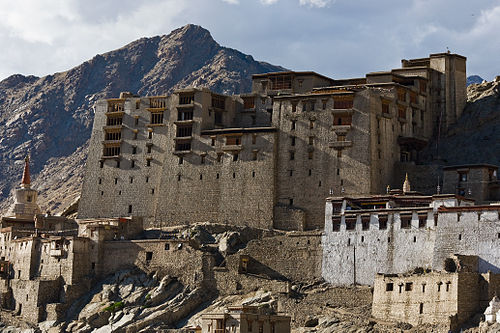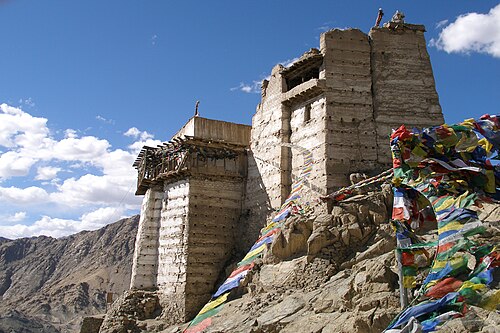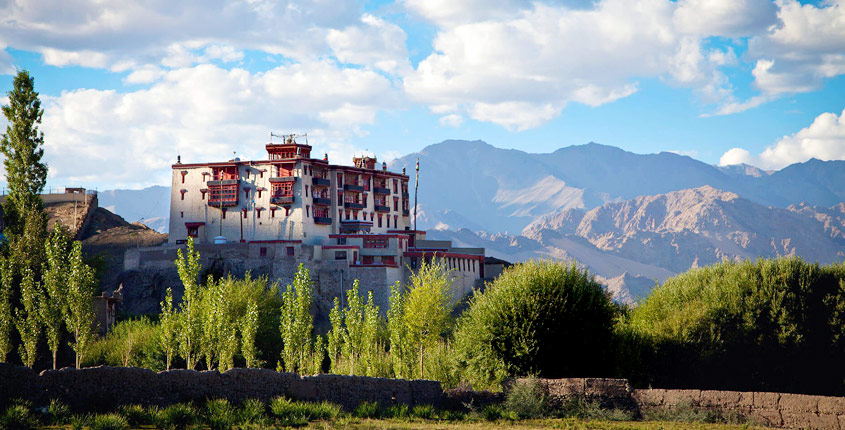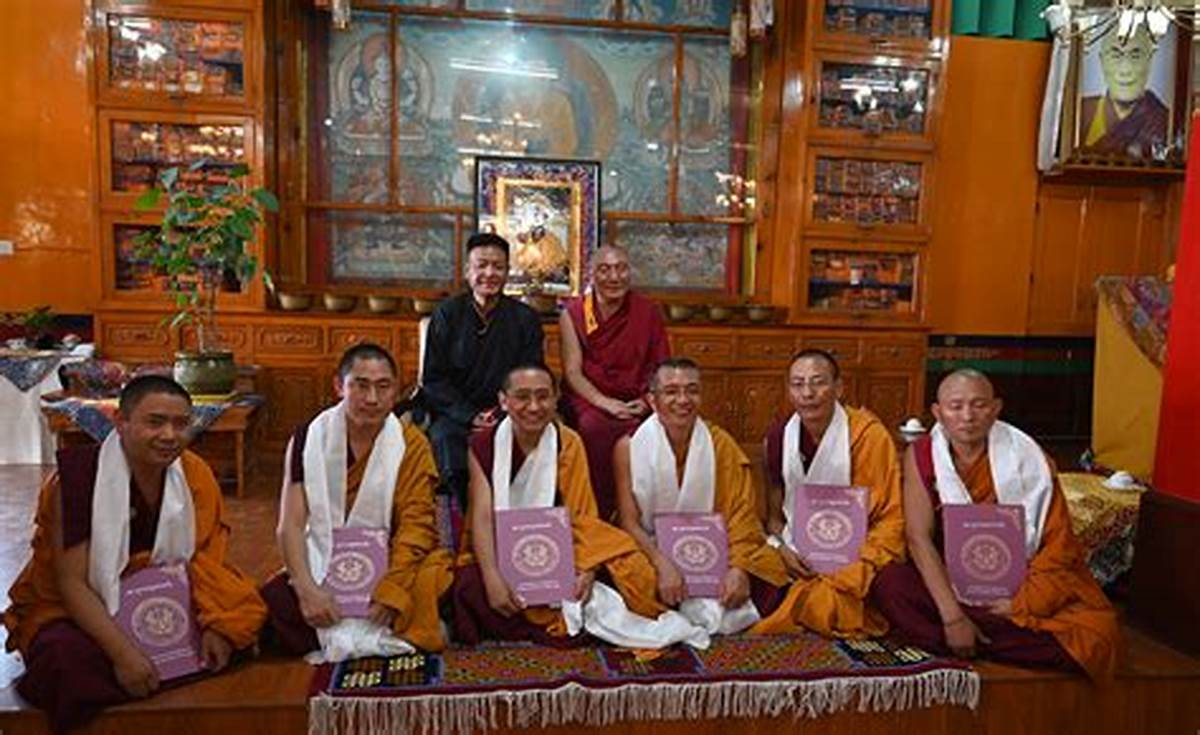Besides monasteries, the 9 storey Leh Palace, Stok Palace Museum, Mahabodhi International Meditation Centre and the Central Institute of Buddhist Studies Choglamsar, Mosque and Moravian Church at Leh are added attraction for the tourists.
Leh Palace
 Leh Palace, also known as Lachen Palkar Palace, is a former royal palace overlooking the city of Leh in Ladakh, India. It was constructed circa 1600 AD by Sengge Namgyal. The palace was abandoned when Dogra forces took control of Ladakh in the mid-19th century and forced the royal family to move to Stok Palace.
Leh Palace, also known as Lachen Palkar Palace, is a former royal palace overlooking the city of Leh in Ladakh, India. It was constructed circa 1600 AD by Sengge Namgyal. The palace was abandoned when Dogra forces took control of Ladakh in the mid-19th century and forced the royal family to move to Stok Palace.
It is nine storeys high; the upper floors accommodated the royal family, while the lower floors held stables and store rooms. Much of the palace is in deteriorated condition, and little survives of its interior decorations. The Palace Museum holds a rich collection of jewellery, ornaments, ceremonial dresses and crowns. Tibetan thangka or paintings, which are more than 450 years old, with intricate designs still retain the bright colours derived from crushed and powdered gems and stones. Structures around the palace's base include the prominent Namgyal Stupa, the colourfully muraled Chandazik Gompa and the 1430 Chamba Lhakhang with medieval mural fragments located between the inner and outer walls.
The palace is being restored by the Archaeological Survey of India. The palace is open to the public and the roof provides panoramic views of Leh and the surrounding areas.
Tsemo Castle
 Tsemo Castle (also known as Namgyal Tsemo or Leh Fort complex) is an important religious and historical point in Leh, Ladakh, India. It is located at a walking distance from the Leh Palace. The defensive structure is maintained by Archaeological Survey of India.
Tsemo Castle (also known as Namgyal Tsemo or Leh Fort complex) is an important religious and historical point in Leh, Ladakh, India. It is located at a walking distance from the Leh Palace. The defensive structure is maintained by Archaeological Survey of India.
It is located at the highest point in Leh. The castle is believed to have been built during the time of Tashi Namgyal (1555-1575).
Stok Palace
 Stok Palace is one of the finest attractions of Leh and probably one of the most visited too. Which was once home to the king of Ladakh is now converted into a heritage hotel. It won't be wrong to say that Stok Palace is the perfect reflection of the glorious past of Namgyal's reign in Ladakh. It is believed that the palace was also the summer home of King Sengge Namgyal and his descendants. The palace was established by King Tsepal Namgyal back in 1820 and then it was opened by the Dalai Lama in 1980 for public visits.
Stok Palace is one of the finest attractions of Leh and probably one of the most visited too. Which was once home to the king of Ladakh is now converted into a heritage hotel. It won't be wrong to say that Stok Palace is the perfect reflection of the glorious past of Namgyal's reign in Ladakh. It is believed that the palace was also the summer home of King Sengge Namgyal and his descendants. The palace was established by King Tsepal Namgyal back in 1820 and then it was opened by the Dalai Lama in 1980 for public visits.
There is also a museum that is located in the Stok Palace. Additionally, there is a temple too. The rooms and other attractions inside the Stok Palace are rustic but charming. The quirky decoration of the place is so well-done that you enjoy your time throughout the stay. All-in-all, Stok Palace is a traditional attraction that is very important for the people of Ladakh.
Mahabodhi International Meditation Centre
 The Mahabodhi International Meditation Centre (MIMC) had its humble beginnings in one small rented room in Leh city in 1986 when Venerable Bhikkhu Sanghasena realized there was a great need to offer both humanitarian and spiritual services to the people of Ladakh.
The Mahabodhi International Meditation Centre (MIMC) had its humble beginnings in one small rented room in Leh city in 1986 when Venerable Bhikkhu Sanghasena realized there was a great need to offer both humanitarian and spiritual services to the people of Ladakh.
From there the centre moved to the main Devachan campus in Choglamsar which is on an impressive 250 acres of desert land in 1991. Against all odds, with no water, no proper roads and just harsh desert sand, through the tenacity, compassion and resourcefulness of Venerable Sanghasena and his team, the Mahabodhi Devachan campus began to grow and flourish and his dream slowly became a reality.
Central Institute of Buddhist Studies Choglamsar
 The Mahabodhi International Meditation Centre (MIMC) had its humble beginnings in one small rented room in Leh city in 1986 when Venerable Bhikkhu Sanghasena realized there was a great need to offer both humanitarian and spiritual services to the people of Ladakh.
The Mahabodhi International Meditation Centre (MIMC) had its humble beginnings in one small rented room in Leh city in 1986 when Venerable Bhikkhu Sanghasena realized there was a great need to offer both humanitarian and spiritual services to the people of Ladakh.
From there the centre moved to the main Devachan campus in Choglamsar which is on an impressive 250 acres of desert land in 1991. Against all odds, with no water, no proper roads and just harsh desert sand, through the tenacity, compassion and resourcefulness of Venerable Sanghasena and his team, the Mahabodhi Devachan campus began to grow and flourish and his dream slowly became a reality.

